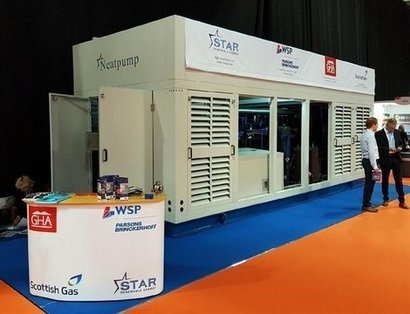
An industrial-size air source heatpump capable of delivering affordable low-carbon heating and hot water for vulnerable households on Scottish housing estates was presented at the UK’s largest renewable energy conference and exhibition, All-Energy yesterday (5th May 2016).
The heat pump was developed by a joint partnership between Glasgow Housing Association (GHA), energy consultants WSP Parsons Brinckerhoff, heat pump manufacturers Star Renewable Energy and Scottish Gas. The new heating technology is expected to become the pathway to zero carbon, cheap heating for existing social housing stock. The 400 kWh air source heatpump is designed to be installed at an energy centre and connected to a centralised district heating network which will deliver low-carbon heat to six buildings plugged into the scheme.
“We’re looking to gain fuel poverty alleviation for Hillpark Drive, a 350 home social housing estate built in the 1970s currently fitted with electric storage heating, to build a more sustainable community” said Colin Reid, Energy & Sustainability Manager at GHA, part of the Wheatley Group. “Heatpumps weren’t even a factor at the inception of this project as we had never thought it would be possible to work with heat pumps on this scale. GHA has only worked with small, individual heatpumps which we found to be unsuccessful. However, this is a different beast.”
The heat pump is 8 metres long and weighs 10,000 kilograms. It incorporates in-built control systems to enable remote monitoring and ensure optimum efficiency throughout its life-cycle, expected to be around 20 years or more. It uses robust industrial manufacturing components, achieving higher water temperatures of 60°C, allowing for the use of regular radiators.
Air source heatpumps are perfect for the UK’s mild climate as warmth is extracted from the outside air and then boosted up for distribution via a “wet” central heating system to the whole housing community. This will be the first time an ASHP installation in Britain will provide central renewable heating for a block of high rise buildings.
“Many people believe that renewable energy is solely for modern buildings, however our new development demonstrates that this is most certainly not the case” added Dave Pearson, Director of Glasgow based Star Renewable Energy. “In the UK, 99 percent of our properties already exist. If the government’s ambitious targets for a complete cessation of fossil fuels for heating is to be realised, we need sustainable and lower cost central community heatpumps capable of retrofit without the constraints and high infrastructure costs associated with other renewable technologies.”
Details of the different options and factors affecting deployment of other low carbon technologies in the Hillpark Drive project were delivered by Ewan Jures, Principal Engineer at WSP, adding that they could not be deployed as “cost-effectively and rapidly” as the community air source heat pump. Mr Jures explained that biomass suffers from access for deliveries, air quality concerns and flue stacks. Combined heat and power is off the gas grid and has low export prices while ground source heat pump are not an option either because there is a lack of available and suitable grounding in the area. Water source heat pumps are also unsuitable as there is no body of water nearby.
The new heat pump was welcomed by Jack Welsh, Scottish Gas Technical Sales Manager – Heat Networks, who said that what he likes about it is that the modular unit is self-contained and can be delivered to a site as a plug and play product, allowing the technology to be fully controllable and easier to maintain. Scottish Gas has an active programme to engage local housing associations in developing renewable district heating projects and according to Welsh, they are “looking forward to developing similar projects in the near future.”
Support for heatpump technology in Scotland is growing in line with the country’s target to remove all carbon from heating systems by 2050. The intention is to further decarbonise the grid, which help to improve the performance of the heatpump and bring carbon emissions down.
The All-Energy conference and exhibition is a major highlight in the renewable industry calendar. Attracting representatives from a whole host of renewable sectors, including onshore and offshore wind, bioenergy, wave and tidal, sustainable cities and energy efficiency, the exhibition provided attendees with the unique opportunity to learn more about the innovative new developments in the industry.
For additional information:

